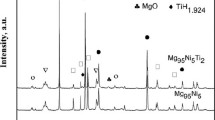Abstract
Hydriding combustion synthesis (HCS) has been regarded as an innovative process for the preparation of high active magnesium-based hydrogen storage alloys. For the purpose of understanding the interrelation of the unique hydrogen storage properties and the surface characteristics of the HCS product, the samples of Mg2Ni alloy/hydride with and without exposure to air were prepared from the HCS product of Mg2NiH4. The hydriding and dehydriding properties were compared and the surface compositions were analyzed by means of X-ray photoelectron spectroscopy (XPS) and auger electron spectroscopy (AES). It was shown that the air exposure considerably decreases the hydriding activity of Mg2Ni. Absorbing of 3.0 wt.% of hydrogen under the conditions of 603 K and 3.0 MPa after the air exposure takes 1500 s, which is six times longer than for the unexposed alloy. The hydrogen desorption of the hydride are also impeded by the air-exposure, which results in the increase of dehydriding temperature from 450 K to 540 K. XPS and AES analyses indicated that Mg segregates and exists in the form of hydroxide on the surface of the air-exposed sample, which is responsible for the degradation of the hydriding and dehydriding properties. It was confirmed that the fresh surfaces generated during the dehydriding process of the as-synthesized hydride product contributes to the high activity of the HCS product in the first cycle of the hydriding determination.




Similar content being viewed by others
References
Janot R, Aymard L, Rougier A et al (2004) J Phys Chem Solid 65:529
Cai G, Chen C, Chen Y et al (2003) Int J Hydrogen Energy 28:509
Funaki K, Orimo S, Fujii H, Sumida H (1998) J Alloys Compd 270:160
Orimo S, Fujii H (1996) J Alloys Compd 232:L16
Akiyama T, Li L, Yagi J (1997) J Alloys Compd 252:L1
Li L, Akiyama T, Yagi J (2001) Int J Hydrogen Energy 26:1035
Saita I, Li L, Saito K, Akiyama T (2002) Mater Trans 43:1100
Li L, Saita I, Akiyama T (2004) J Alloys Compd 384:157
Li Q, Lin Q, Jiang L, Chou K (2004) J Alloys Compd 368:101
Li L, Akiyama T, Yagi J (1999) Intermetallics 7:671
Saita I, Li L, Saito K, Akiyama T (2003) J Alloys Compd 356–357:490
Liu D, Zhu Y, Li L (in press) Int J Hydrogen Energy, doi: 10.1016/j.ijhydene.2006.11.021
Liu X, Zhu Y, Li L (2006) J Alloys Compd 425:235
Akiyama T, Saito K, Saita I (2003) J Electrochem Soc 9:E450
Zhang SG, Yorimitsu K, Nohara S et al (1998) J Alloys Compd 270:123
Schlapbach L (1992) Hydrogen in intermetalic compounds II. Springer-Verlag, p 43
Zaluski L, Zaluska A, Ström-Olsen JO (1997) J Alloys Compd 253–254:70
Acknowledgements
This research is supported by the National Hi-Tech Research and Development Program of China (863 Program) (Grant No. 2007AA05Z110), the Hi-Tech Research Program of Jiangsu Science and Technology Department of China (Grant No. BG2007052) and the Natural Science Foundation of the Jiangsu Higher Education Institutions of China (Grant No. 06KJB430036).
Author information
Authors and Affiliations
Corresponding author
Rights and permissions
About this article
Cite this article
Liu, D., Zhu, Y. & Li, L. Effect of surface oxidation on the hydriding and dehydriding of Mg2Ni alloy produced by hydriding combustion synthesis . J Mater Sci 42, 9725–9729 (2007). https://doi.org/10.1007/s10853-007-2037-4
Received:
Accepted:
Published:
Issue Date:
DOI: https://doi.org/10.1007/s10853-007-2037-4




